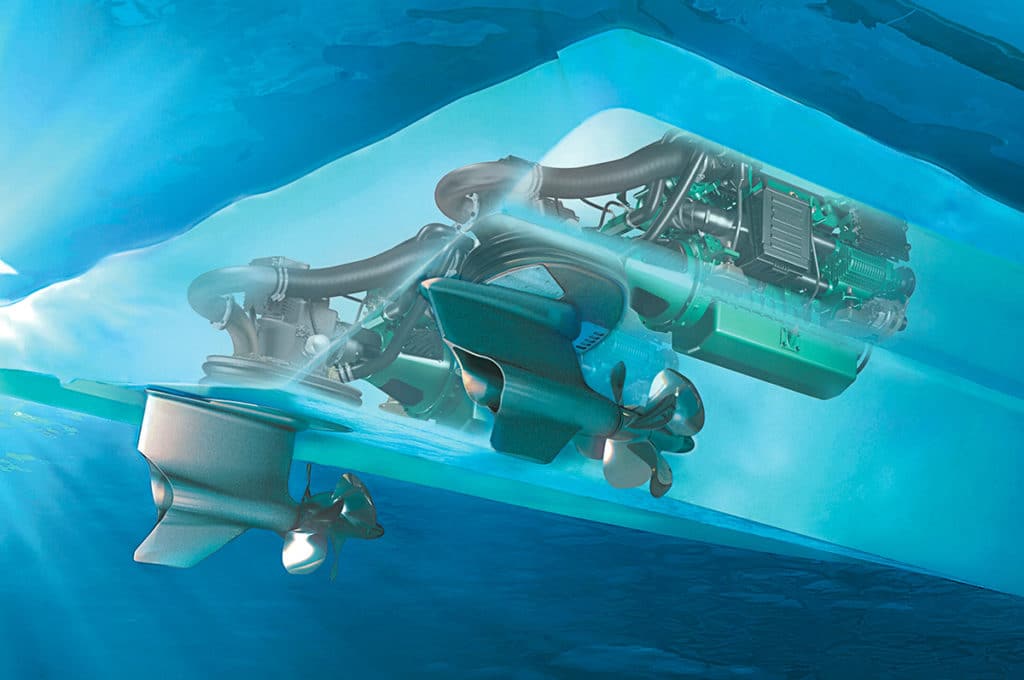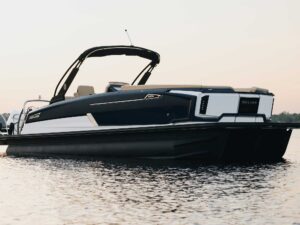
To say I was impressed following a sea trial of a Tiara 4300 Sovran in 2005 would be an understatement. Sure, the boat proved top-notch, but it was the propulsion, a new thing from Volvo Penta called the Inboard Performance System, or IPS, that really got my juices percolating. With IPS, the Tiara delivered better speed, efficiency and maneuverability. Let’s take a look at where IPS is today with 20,000 units now in the field, focusing especially on the new IPS 15.
I traveled to Krossholmen, Sweden, where Volvo Penta maintains a test facility housing a platoon of engineers and a fleet of test boats in order to test the newest generation of IPS. The IPS 15 is the fourth version of this propulsion system and was developed to work with the also new D8 series of Volvo Penta marine diesel engines. IPS 15 works with engines rated between 450 and 600 hp.
IPS 15 fills the slot between the smallest IPS 10 and the larger IPS 20 drive. The IPS pod range can now mate with engines ranging between 260 and 900 hp. In ascending order, the drives are IPS 10, IPS 15, IPS 20 and IPS 30.
It’s important to note that while the drives are designated with the IPS prefix, IPS is an entire system that includes drive, engine, and control and monitoring capabilities.
It was IPS that, arguably, put joystick control in the hands of mainstream boaters (by virtue of sheer numbers compared to the jet-joystick systems that debuted about the same time), and the Atlantis Sport Yacht I ran proved as easy to maneuver with a joystick at dockside as any of the dozens of IPS-powered boats I have tested since that first Tiara. It was also fast, efficient, and delivered sporty handling at cruising speeds.
Yet while all the hallmarks of IPS are in attendance, IPS 15 also offers new features that deliver new advantages.
For instance, IPS 15 provides the widest steering angle — 34 degrees of azimuth — of any IPS drive to date. This wide angle makes slow-speed operations even easier; for instance, it allows tremendous control with the wheel alone while backing into a slip at speeds under 1,000 rpm.
Dynamic Position System (DPS) is another new feature. Hit the DPS button and the boat holds its heading and remains in position within a few yards. Station-keeping systems, like DPS, prove especially helpful when awaiting a bridge opening or while queued up, holding off a fuel dock. While a special antenna that houses two GPS receivers provides the data, the precision positioning is made possible by the ability of the IPS pods to rotate independently.
Corrosion protection is enhanced by the Advanced Corrosion Protection system (ACP). This is an impressed-current, anti-corrosion system that works in concert with titanium-coated anodes. Essentially, it produces the correct amount of current to protect the drives, but if the battery voltage drops below 75 percent, it protects through the anodes. If ACP detects the battery voltage dropping below 50 percent, protection is via the anodes alone. Installation is plug-and-play, requires no input by the boat owner, and can protect up to four IPS drives.
Additionally, IPS 15 offers the best weight ratio of any IPS drive to date, and increased streamlining provides even better hydrodynamics, both of which enhance efficiency. Even the hull-to-drive interface has been improved and made smaller.
Volvo Penta preaches “easy boating.” The new IPS 15 puts truth to that theme.
IPS Model Designations
IPS engine-model numbers represent the conventional inboard engine equivalent power, not the rated horsepower of the engine they emblazon. For instance, the new IPS 800 produces 600 horsepower but, due to increased efficiency, delivers the equivalent performance of an 800 hp shaft inboard.









